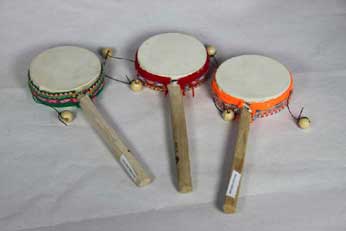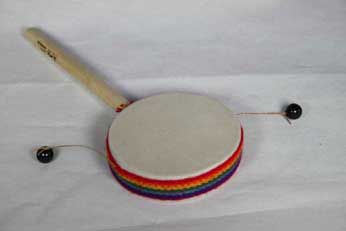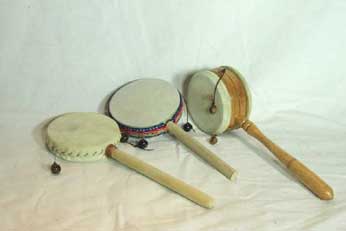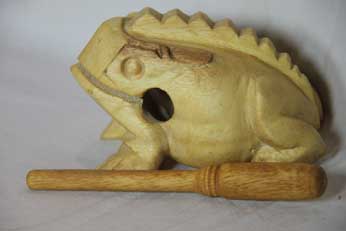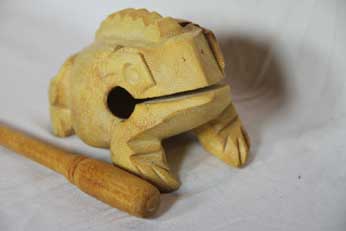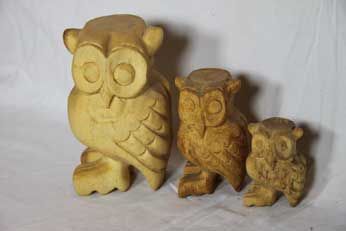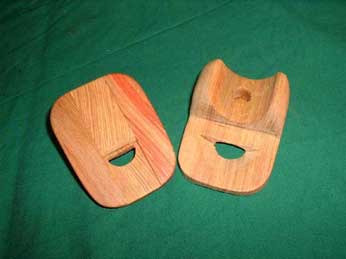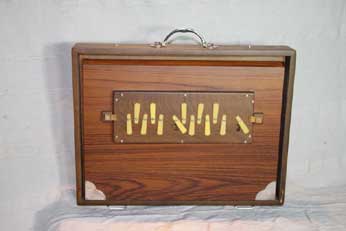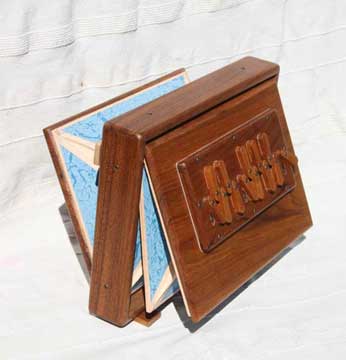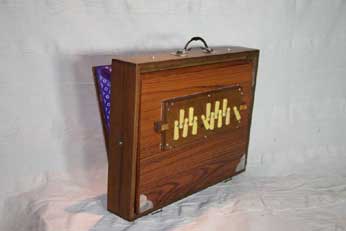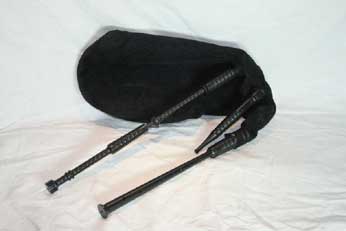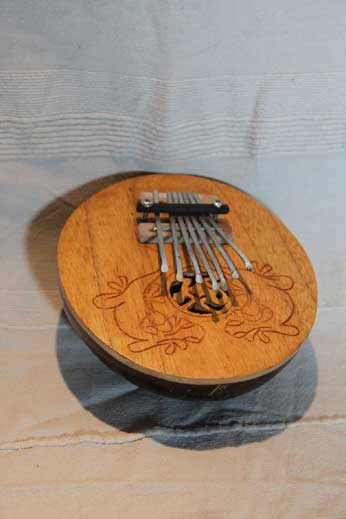Klangmalerei, Kurioses
Drehtrommeln, Klangtiere Frosch oder Eule, Nasenflöte, Shrutibox
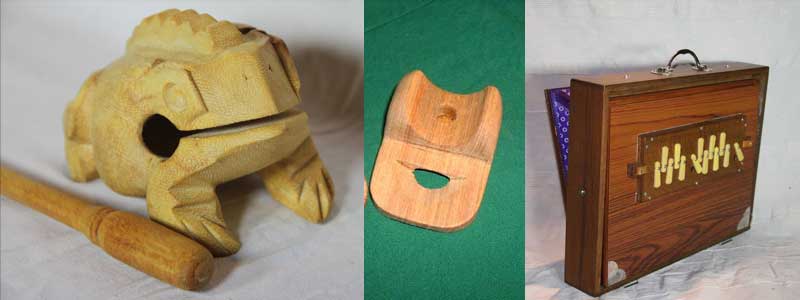
Das monotone Trommeln der Drehtrommel, das Quaken der Klangfrösche, das Pfeifen der Nasenflöte, das Singen der Shrutibox
Percussionsinstrumente dienen zur Klangmalerei.
Manche erzeugen ein gleichbleibendes Geräusch wie die Drehtrommeln oder die Shrutibox, ein einfaches Harmonium.
Manches Instrument ahmt Tierstimmen nach wie die Klangfrösche oder Eulenflöten.
Und auch die kuriose Nasenflöte kann Vogelstimmen nachahmen, aber auch Lieder spielen.
Schon an anderer Stelle haben wir die vielen Klänge der Rasseln erwähnt oder die Oceandrum, die ein Meeresrauschen erzeugt.
Auch auf Zimbeln, Klangstäbe oder Gongs soll hier noch einmal verwiesen werden.
Drehtrommeln
Am Griff gedreht schlagen die Kugeln an den Bändern auf die Trommelfelle. Langsam gespielt kann es beruhigend wirken, mit schnellem Tempo wird es ein lautes Trommeln, welches Aufmerksamkeit erregt.
in verschiedenen Grössen, Holz mit Ziegenfell
Frosch und Eule
Tierstimmen nachahmen mit Klangfrosch oder Eulenflöte
Eine aus Holz geschnitzte hohle Froschfigur. Reibt man mit dem Stab über den Rücken des Frosches ertönt ein quakendes Geräusch. Je nach größe des Frosches kann es da ein eher leises helles quaken sein oder ein lautes tiefes.
Die Eulen sind aus dem gleichen Holz geschnitzt und als Flöten gebaut. Bläst man oben am Kopf in die Pfeife ertönt ein dumpfer Eulenruf. Je nach Größe entstehen hier auch Klänge vom kleinen Käuzchen bis zur grossen Eule.
Nasenflöte
Nasenflöten werden mit der Nase geblasen, der Mundraum ist der Resonanzkörper und formt die verschiedenen Töne.
Eine sehr originelle Flöte, die Tradition kommt aus dem Südseeraum.
Diese Flöte wird nicht mit dem Mund geblasen, sondern, wie der Name schon vermuten lässt, mit der Nase.
Ebenso werden die Töne nicht über Fingerlöcher gespielt, sondern der Mundraum dient als Resonanzkörper und über die Größe des Mundraumes kann man die Töne modulieren, ähnlich wie bei der Maultrommel.
Die von uns angebotenen Nasenflöten sind aus Nadelholz gefertigt und mit Leinölfirnis behandelt.
Spielweise:
Die Nasenflöte wird so vors Gesicht gehalten, das das runde Loch unter der Nase liegt und das halbmondförmige Loch vor dem Mund.
Die Nase bläst in das runde Loch, der Mund ist leicht geöffnet vor dem halbmondförmigen Loch.
Mit Veränderung der Mundhöhle werden verschiedene Töne erzeugt.
Shrutibox
Die Shruti-Box ist ein kleines Harmonium, Über einen Blasebalg werden Metallzungen zum Schwingen gebracht. Über Klappen können verschiedene Akkorde gestimmt werden.
Die Shruti Box ist ein einfaches Harmonium.
Über einen Blasebalg, der mit der Hand betätigt wird, werden Metall Durchschlagzungen in Bewegung gebracht und ein der Mundharmonika ähnlicher Klang erzeugt.
Über Klappen kann man bestimmte Töne erklingen lassen oder eben verschliessen. So lassen sich verschiedene Akkorde einstimmen.
Die Shruti Box ist kein Melodieinstrument, sondern ein Bordun-Begleitinstrument.
So wird sie bevorzugt als Begleitung zum Gesang verwendet.
Tonumfang: C bis d (None) chromatisch
Grösse: 45 x 33 x 8 cm
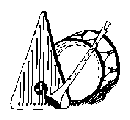
 English
English
 French
French
 German
German
